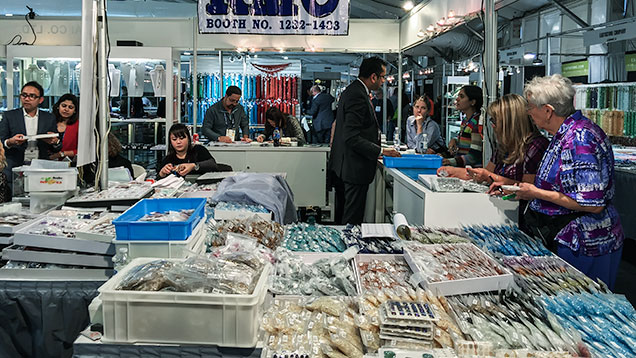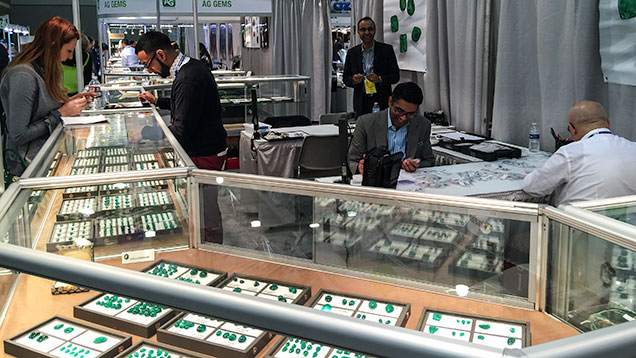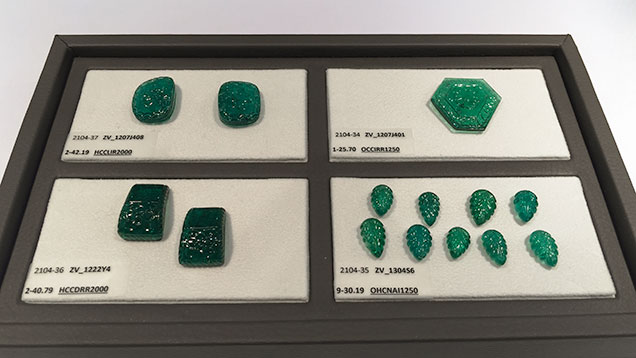Tucson 2016

For decades, buyers and sellers from every aspect of the gem and jewelry industry have flocked to the gem fair in Tucson, a town in the heart of Arizona’s Sonoran Desert that is rich in cultural and natural heritage. The annual shows are widely considered a forecast for the rest of the year. While the shows of the past few years have reflected a sluggish industry, the atmosphere in 2016 was dramatically different, with an increase in both attendance and business. The 34th AGTA GemFair saw record pre-registration numbers, and more than 300 exhibitors greeted a full house of buyers on the opening day. Gabrièl Mattice of Pala International (Fallbrook, California) said that sales were very strong this year, even on the first day of the show. The energized interaction between exhibitors and buyers was evident throughout the convention center. Though diamond sales have slowed, colored stones have gradually gained momentum among jewelry customers, and designers are responding in kind. Although the overall market share for colored stones is still small compared to the diamond sector, efforts to promote them have had very positive results.
More Serious Buyers. After the surge of foot traffic on the opening day, attendance remained stable at the shows for the rest of the week (figure 1). Vendors saw fewer Chinese buyers than in 2014, though Josh Saltzman of Nomad’s Co. (New York) indicated that those who came were serious buyers picking up high-quality goods. Gaurav Shah from Real Gems Inc. (New York) confirmed that his company has seen greater demand for emerald in mainland China since 2007, a market that slowed in 2015. He said that the Chinese are more cautious and specific in their purchases, and he predicted an upswing in Chinese buying activity in the near future. Joseph Nakamura of Shogun Pearl (White Plains, New York) said that 95% of his customers were from the United States, while Gabrièl Mattice also saw many Europeans on the floor, especially French buyers. Many new buyers attended, possibly due to the stabilized prices and heightened interest in colored stones (figure 2). Mr. Shah observed three categories of clients in Tucson: buyers from television and Internet companies, retailers, and designers.

David Bindra of B&B Fine Gems (Los Angeles) noted that the number of transactions relative to the attendance was much higher than in previous years. He felt that this year’s AGTA show was much better than the September 2015 Hong Kong Jewellery and Gem Fair, where many sellers felt the slowdown of the mainland Chinese market.
Calibrated Goods. Though high-end colored gems continue to set auction records, the market for these stones remains slow. As a result, the colored stone trade still mainly consists of goods in standard calibrated sizes rather than custom-cut material (figure 3). Many cutting factories are able to provide a greater selection of sizes that fit their clients’ requirements. This especially benefits the jewelry manufacturers in China and India, as setting calibrated gems is the bulk of their workload. Thus, mid-priced colored goods were the overall best sellers in Tucson. Nirmal Bardiya of RMC Gems (Bangkok) informed us that calibrated goods of various millimeter sizes are best sellers in the American market, while Arthur Groom Jr. of Eternity Natural Emerald (Ridgewood, New Jersey) noted that Afghan emerald melee is one of his biggest sellers. Guarav Shah reported that the most popular calibrated cuts are oval, emerald, and pear shapes; these goods generally range from $200–$2,000 per carat.

Classics. No single stone stole the show this year. Some relatively new varieties were available, but their potential is still hard to evaluate. Some people asked about the color-change pink pyrope garnet that has recently been covered by multiple trade magazines, including the Winter 2015 G&G. Ms. Mattice said it will take time to educate people about this stone, and it is not easy to predict the market potential. Mr. Bardiya informed us that morganite (figure 4), aquamarine, and blue topaz were popular among RMC’s American clients. According to Joseph Nakamura, white pearls still dominate, while other colors come and go with different fashion trends. According to multiple dealers, Paraíba tourmaline is still in high demand (figure 5).


Even so, the “big three” of ruby, sapphire, and emerald still dominate the market and fetch higher prices, which was reflected in this year’s shows. Corundum is still the most popular material in the high-end sector. David Bindra and Gabrièl Mattice both said that sapphires sold very well, and Mr. Bindra thinks that blue and green material will be especially strong this year, though yellow sapphires drew more interest than at previous shows. Pink and pastel-colored sapphires also attracted many buyers, perhaps because they evoke rose quartz and serenity blue, Pantone’s colors of the year for 2016.
Interest and Demand for Color. As one of the best platforms to trade and promote colored gemstones, the Tucson shows provide buyers with the finest goods sourced from all over the world. Some one-of-a-kind stones debut here, such as the 332.24 ct Imperial Flame topaz carving. Spectacular stones such as these usually attract immediate attention.
Mr. Bindra tied the increase in sales to a growing awareness of colored stones. Once-daunted consumers are becoming more knowledgeable about different varieties and are better prepared before they purchase. This interest in learning was reflected at the AGTA GemFair seminars, which saw a 30% increase in attendance.
Greater appreciation for colored stones motivates designers and retailers to source more of them (figure 6). Mr. Shah did business with more designers than in previous shows. The authors themselves saw materials in more unique cuts that seemed intended to capture the designers’ imagination (figure 7). Mr. Shah said that even though Real Gems is a wholesaler, the company does not have a minimum order requirement for any buyers. This is very helpful for many designers, especially the young ones. This exhibitor feels that it is worthwhile to do business with people who are willing to work with and promote colored stones in their own work.


Summary. Based on their own observations, the authors were not surprised to hear vendors say that this was one of the strongest Tucson shows in recent history. People were encouraged by the renewed momentum of the American market, even though high-end buyers were still cautious. Relatively stable prices also contributed to increased sales, although the price of sapphire, ruby, and emerald remained high. With the positive forecast from Tucson, the trade is expecting a prosperous 2016.
We thank the many exhibitors who provided insight, photos, and materials.



